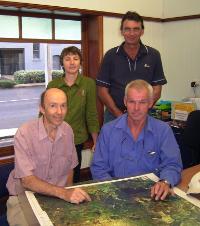Weed adds to flood damage in CQ
Published on 22 February, 2008

CQU's Dr Leo Duivenvoorden (front left) discusses the Hymenachne control project with Fitzroy River Coastal Catchments' Chantelle James, Livingstone Shire Council's Glenn McIntyre (rear) and Ian Dare (front).Flood waters throughout Central Queensland may have worsened the existing Hymenachne weed problem in the region's creeks and rivers.
According to Central Queensland University's Leo Duivenvoorden, the weed now infests many kilometres of creeks and rivers in the region and is becoming more widespread.
"This is a very serious problem because of the weed's potential to spread to many more areas, interfering with boating and fishing and reducing biodiversity," he explained.
"The weed can completely grow over and kill native vegetation, choking creeks and wetlands, and preventing people from using these areas for recreation. It will also destroy the value of the areas for native wildlife."
The weed can destroy boat moorings in the river during floods and create quite a clean-up bill for those wanting to keep our beaches clear of the weed.
Dr Duivenvoorden said a lot of the weed along the Fitzroy River (which also includes Aleman and para grass) has been washed into Keppel Bay, but much is still left in the smaller creeks that have not been scoured by fast flows.
"This remaining weed will regrow and cover the waterways again if it is not controlled by spraying."
Dr Duivenvoorden and others at CQU are undertaking a research project into the control of the weed in the region. They are partnered by Livingstone Shire Council and the Fitzroy River Coastal Catchments.
The project aims to examine the potential control options for the weed, with a particular focus on spray control.
Livingstone Shire Council has been conducting the spraying for the project, although the wet season has prevented it in recent times. More spraying will be done once conditions dry up to the stage when vehicles can again access the stream banks.
"We hope to better understand the best way to spray the weed while reducing environmental harm. We are also gathering people's views on issues related to the management of the weed, including the costs associated with the weed and the importance of controlling it versus other issues.
The project is expected to finish mid-year, although recent flooding may see the project extended.

